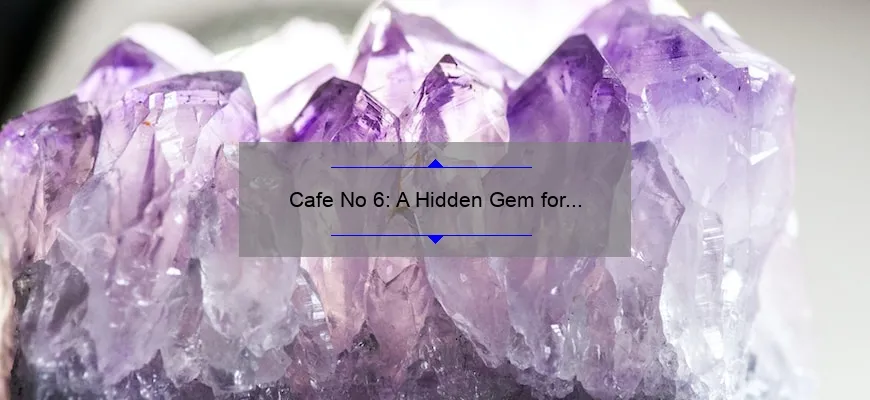**Short answer lao cafe:**
Lao Cafe is a restaurant located in the Uptown neighborhood of Chicago, Illinois. The restaurant offers traditional Laotian cuisine in a modern and casual ambiance. The menu emphasizes dishes such as papaya salad, Laotian noodle soup, and skewered meat dishes grilled over charcoal.
- Getting to know Lao Cafe: A Beginner’s Guide
- Step-by-step instructions for making your own Lao Cafe at home
- What ingredients do I need for Lao Cafe? Frequently Asked Questions
- Top 5 essential tools and equipment for a perfect Lao Café experience
- Exploring the cultural significance of Lao Café: A Window into the Heart of Laos
- Health benefits of drinking Lao Coffee: Why you should add it to your daily routine
Getting to know Lao Cafe: A Beginner’s Guide
For anyone who is new to Lao cuisine, visiting a Lao cafe can be quite an experience. This exciting journey of discovering new flavors and textures may leave you feeling overwhelmed at first, but don’t worry – we’ve got you covered! In this beginner’s guide, we will introduce you to the unique tastes and aromas of Lao cuisine, as well as some tips on what to order when dining at a Lao cafe.
Firstly, it’s important to note that Lao cuisine is heavily influenced by its neighboring countries such as Thailand and Vietnam. However, it has its distinct identity with emphasis on sticky rice served with various dips or dishes, like papaya salad (tam mak hoong) and laab (spicy minced meat salad). Similar to most Southeast Asian cooking, spices are always present in the food; The lack of saltiness however sets the food apart from other cuisines from the region – fish sauce is used more often than pure salt.
If you’re not sure what to try first, tam mak hoong is a great option for those who love spicy food. It’s made with shredded green papaya mixed with tomatoes, lime juice, chilies and fish sauce – a perfect blend of sweet and sour flavors that are sure to awaken your taste buds. Another traditional dish that’s worth trying is laab salad. This famous street food dish consists of stir-fried minced meat which can be chicken or beef seasoned with various types of herbs such as Lemongrass , mint leaves and ground roasted rice before serving on lettuce cups.
If salads aren’t your preferred choice , remember seafood dishes are also very popular across Laos – over 70% of the country being landlocked mean people rely on freshwater fish for their main protein source along with local river shrimp. One particular dish praised highly in traditional culture would be Mok Pa (steamed fish in a banana leaf parcel), gently steam cooked in the banana leaf wrapping together with a selection of herbs, chillies and spices to create an aromatic fish dish.
Another typical Lao dish is the savory lemongrass skewers known as “ping.” These can be made using chicken, beef, or pork marinated in flavorful lemongrass before being grilled over an open flame. If you’re feeling daring try dipping into the pungent dipping sauce served on the side, but don’t say we didn’t warn you – it’s seriously spicy!
Lastly, no trip to a Lao cafe is complete without trying some sweet treats from their desserts which are generally rice-based; one popular option could be Nam Van (jasmine and coconut milk jelly), Laotian pride themselves on how fresh each dessert’s ingredients should be along with servings that won’t lead to any sugar crashes later.
So there you have it – our beginner’s guide to exploring Lao cuisine at a cafe. Whether you’re looking for something spicy or sweet, these traditional dishes will not disappoint with bountiful flavors yet still resemble healthy eating culture prevalent within Laos . So why not step outside your culinary comfort zone and get adventurous with these unique tastes and aromas? You may just discover your new favorite cuisine!
Step-by-step instructions for making your own Lao Cafe at home
Have you ever been to a Lao Cafe and felt the tantalizing aroma of the unique spices that fill the air? Have you ever wished to recreate those authentic flavors at home? Well, you’re in luck because we have created step-by-step instructions for making your very own Lao Cafe right from your kitchen.
Firstly, let’s start with the base – sticky rice. Rinse one cup of glutinous rice until completely free of starch. Soak it in water for at least 2 hours or even overnight if possible. Once done, place it in a steamer basket lined with cheesecloth and steam it on high heat for around 20 minutes.
Now comes the exciting part – spicing up our Lao dishes. Starting with ‘Larb’, a dish made of minced meat (chicken, pork, or beef), mix together lime juice, fish sauce, chili powder, and red onions to create a powerful dressing. Add this dressing into cooked meat and mix till fully coated.
Next up is ‘Tam Mak Houng,’ also known as Papaya Salad. First off take half a green papaya and shred it into thin pieces then add tomatoes cut into thin slices along with garlic cloves thinly chopped and dried shrimp mixed wiht tamarind paste – this should create an aromatic smell amidst solid ingredients.
To get more flavor into your Lao Cafe recipe list, grill some chicken wings till crunchy yet tender. Marinate these wings in soy sauce wet spice mixture using sesame oil as well as scallions before grilling them – adding even more vivid texture & flavor here!
Finally pouring glasses full of sweet Tea colada made using coconut cream instead condensed milk! Not only refreshing drink within but also perfect accompaniment just like sticky rice while indulging scrumptious dishes prepared by yourself
And voila! With these easy-to-follow steps and delicious ingredients- you can now enjoy your mouth-watering Lao Cafe at home! Share it with friends and family for a unique experience, and show off your culinary skills. So go ahead and give it a try – you won’t regret it!
What ingredients do I need for Lao Cafe? Frequently Asked Questions
When it comes to Lao cuisine, there’s a lot of mystery surrounding the ingredients used in traditional dishes. Many people are curious about what ingredients they need to whip up a delicious meal at home that captures the essence of Lao flavors. To demystify this aspect of cooking, we’ve compiled some frequently asked questions about what ingredients you’ll need for Lao Cafe.
Q: Do I need any specialized equipment or tools to cook Lao food?
A: No, you don’t need anything out of the ordinary to prepare and cook Lao dishes! In fact, many recipes can be made with just a basic set of kitchen utensils and appliances. The most important thing is having access to fresh, high-quality ingredients.
Q: What kind of herbs and spices are commonly used in Lao cuisine?
A: Herbs and spices play an important role in many Lao dishes. Some commonly used ones include garlic, ginger, lemongrass, galangal (a type of ginger), coriander (cilantro), Thai basil, mint, and chili peppers. These all add distinct flavors that make traditional Lao meals so unique.
Q: Are there any specific sauces or pastes I should have on hand for cooking?
A: Yes! There are a few staple sauces and pastes that you’ll want to keep on-hand if you plan on cooking many Lao meals. Fish sauce is essential – it adds salty umami flavor to dishes like larb salad and green papaya salad (som tum). Oyster sauce is also often used in stir-fry dishes. Finally, don’t forget about chili paste (nam prik pao) – this adds spicy heat as well as smokiness from roasted chilies.
Q: What proteins are commonly used in Lao cuisine?
A: Like many Southeast Asian cuisines, seafood is very popular in Laos due to its location near the Mekong River. Other common proteins include chicken, pork, beef, and tofu (typically fried to add texture). Lao cuisine is also known for dishes made with game meat like water buffalo or venison.
Q: What are some common vegetables and fruits used in Lao food?
A: Many of the same vegetables that you’d find in other Asian cuisines are used in Lao cooking as well – think onions, garlic, carrots, green beans, and bell peppers. However, there are a few unique ingredients to watch out for. One example is banana flowers – these are often used in salads and have a slightly bitter flavor that pairs well with sweet-tart dressings. Another is kaffir lime leaves – these fragrant leaves add a citrusy aroma to soups and curries.
Hopefully the above answers have given you a better idea about what ingredients you need to prepare delicious Lao dishes! Remember to experiment with different herbs and spices until you find your favorite combination of flavors. With practice and patience, you’ll be able to whip up restaurant-quality meals that showcase the bright and bold flavors of this amazing cuisine.
Top 5 essential tools and equipment for a perfect Lao Café experience
The Lao café experience is one that offers a unique blend of flavors, textures and aromas. If you’re looking to replicate an authentic Lao café experience, then you’ll need some key tools and equipment in your arsenal to ensure everything from brewing the coffee to serving up dishes is done correctly. In this blog post, we’ll explore the top 5 essential tools and equipment for a perfect Lao café experience.
1. The Coffee Grinder
Firstly, let’s start with coffee because no great café is complete without it! In Laos, freshly brewed coffee is something that’s taken seriously and only ground on demand. To achieve this level of freshness in your own Lao café experience, invest in a quality coffee grinder. Not only will it deliver fresh coffee grounds but it also make for better tasting cups of joe.
2. A Mortar and Pestle
A mortar and pestle may seem like an odd addition to any café setting, but it’s an essential tool when it comes to preparing traditional dips like jeow bong or jaew mak khua (spicy tomato dip). Grinding ingredients by hand allows them to release their flavors gradually so you can better control taste and texture.
3. Sticky Rice Steamer
Sticky rice (also known as glutinous rice) is a staple in many Laotian dishes such as larb moo or som tam. Instead of steaming rice in a saucepan over a stovetop like regular rice would be prepared, use a traditional bamboo sticky rice basket called khalat so the sticky texture remains throughout the meal.
4. Wok/Shallow Frying Pan
Lao cuisine features plenty of stir-fries or deep-fried snacks such as fried chive cakes (khuaung puk ded) or spicy chicken wings (peek gai tod grapow), which require the right kind of pan suited for high heat cooking—enter wok/frying pan. Choosing the correct type of wok or frying pan is important for not only achieving tasty morsels but also capturing that authentic smoky aroma when cooking over fire.
5. Chopsticks and Serving Spoons
Finally, what’s a Lao café experience without proper utensils? To truly get an authentic feel, you need serving spoons and chopsticks made from materials like bamboo instead of using traditional stainless steel cutlery. Not only will they add an element of genuine flair to your presentation but it’s a nod towards sustainability, given how quickly plastic pollution is becoming commonplace.
In conclusion, these top 5 essential tools and equipment are key in delivering an authentic Lao café experience. From grinding coffee beans to preparing traditional dips or enjoying sticky rice with chicken in spicy lemongrass soup and fried snacks, each tool serves its purpose in bringing you closer to the food culture found throughout Laos.
Exploring the cultural significance of Lao Café: A Window into the Heart of Laos
Lao Café: A Window into the Heart of Laos, one of the most popular and beloved cafes in London, is a place where you can experience the authentic flavours and rich cultural heritage of Laos. From traditional dishes like papaya salad and sticky rice to exotic herbal teas, this cafe has it all. But what makes it truly unique is not just the food but also its cultural significance which connects people to Lao tradition.
At Lao Café, stepping into its warm atmosphere feels like being transported to Laos itself. The decor boasts intricate wooden carvings that reflect traditional Lao architecture and customs, while the vibrant colours from stylish silk scarfs add an extra dash of authenticity. As for the menu items themselves – each dish carries with it an air of reverence to its origins within Lao culture.
Cafes are more than just places to grab a snack – they are often hubs for communities to gather together and socialize. With such welcoming vibes at Lao Café, customers often find themselves having deep and meaningful conversations with other diners over plates filled with freshly made delicacies.
The knowledge shared by locals creates an engaging atmosphere; staff members have extensive knowledge about Laotian history as well as local customs —knowledge that they incorporate both in their customer service strategies and in conversation with guests.
Many regulars return again and again not only because they love the taste-infused dishes on offer but because they feel a connection to Laos’ diverse traditions- whether through sipping on a fragrant herbal tea or savouring crispy fried snacks hand-prepared by expert chefs who’ve honed their skills working in restaurants across Laos
With so much emphasis placed on western dining experiences these days where everything is fast-paced; it’s refreshing to experience different cultures taking time-honoured traditions seriously. Slow food can soothe our palates; allowing us time to decompress before we dive back into our hectic modern-day lives. What’s more, appreciating different cultures can broaden our perspective and help us appreciate how vast a world we live in.
Lao Café is more than just a place to eat. It’s where you’ll acquire insights about this Southeast Asian country that many people hardly know anything about – its geography, history, people, and most importantly their food and drink culture. And isn’t that worth exploring?
So the next time you’re in London; take some time to visit Lao Café: A Window into the Heart of Laos; after all, it offers so much more than just delicious food — it provides an opportunity to learn about Laotian culture from people who are passionate about sharing their heritage with others.
Health benefits of drinking Lao Coffee: Why you should add it to your daily routine
Lao coffee, or “kaffe” as it is known locally, has been a beloved beverage in Laos for generations. Its reputation has now spread beyond the borders of this Southeast Asian nation and reached coffee lovers all over the world. But did you know that Lao coffee also offers numerous health benefits? Here’s why you should add it to your daily routine.
1) Rich in antioxidants
The primary reason why coffee is considered healthy is its high antioxidant content. Antioxidants fight against free radicals, which are unstable molecules that can cause damage to cells and tissues in our body. The antioxidants in Lao coffee help to reduce inflammation, which is linked with many chronic diseases such as cancer, arthritis, and heart disease.
2) Boosts cognitive function
It’s a well-known fact that caffeine provides a temporary boost to alertness and concentration. However, Lao coffee also contains two other compounds – theophylline and theobromine – which have similar effects but without the side effects associated with excess caffeine consumption (like jitters). Studies show that regular consumption of these compounds improves memory recall and cognitive processing speed.
3) Lowers risk of type 2 diabetes
According to research, drinking four cups of Lao coffee per day can lower your risk of developing type 2 diabetes by up to 25%. This may be due to the presence of chlorogenic acid – a natural compound found in coffee beans – which helps regulate glucose metabolism.
4) Aids weight loss
Caffeine is a popular ingredient in many weight loss supplements because it stimulates fat burning. The same effect can be gained from drinking Lao coffee regularly. Additionally, studies have shown that consuming black coffee before working out can help increase endurance levels so you can burn more calories during your workouts.
5) Promotes good gut health
Lao coffee contains prebiotic properties that promote good bacteria growth within your gut. This results in improved digestion, nutrient absorption, and overall digestive health. The fiber content of coffee also acts as an aid to regular bowel movements.
In summary, Lao coffee is more than just a tasty beverage; it’s a source of numerous health benefits. So go ahead and add it to your daily routine, either black or with a splash of milk, and enjoy the boost of energy and wellness it brings!








